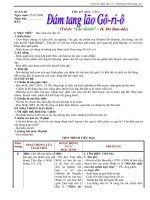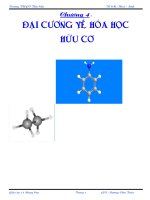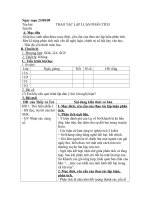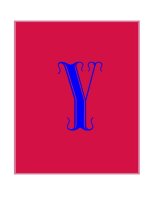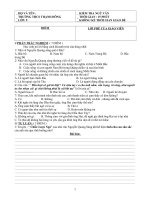A 116 11 (2016)
Bạn đang xem bản rút gọn của tài liệu. Xem và tải ngay bản đầy đủ của tài liệu tại đây (188.55 KB, 6 trang )
Designation: A116 − 11 (Reapproved 2016)
Standard Specification for
Metallic-Coated, Steel-Woven Wire Fence Fabric1
This standard is issued under the fixed designation A116; the number immediately following the designation indicates the year of
original adoption or, in the case of revision, the year of last revision. A number in parentheses indicates the year of last reapproval. A
superscript epsilon (´) indicates an editorial change since the last revision or reapproval.
This standard has been approved for use by agencies of the U.S. Department of Defense.
A641/A641M Specification for Zinc–Coated (Galvanized)
Carbon Steel Wire
A700 Guide for Packaging, Marking, and Loading Methods
for Steel Products for Shipment
A809 Specification for Aluminum-Coated (Aluminized)
Carbon Steel Wire
A856/A856M Specification for Zinc-5 % AluminumMischmetal Alloy-Coated Carbon Steel Wire
A902 Terminology Relating to Metallic Coated Steel Products
2.2 U.S. Federal Standard:
Fed. Std. No. 123 Marking for Shipments (Civil Agencies)3
2.3 U.S. Military Standards:
MIL-STD-129 Marking for Shipment and Storage3
MIL-STD-163 Steel Mill Products, Preparation for Shipments and Storage3
1. Scope
1.1 This specification covers metallic-coated steel fence
fabric having a series of horizontal (line) wires, with vertical
(stay) wires either wrapped around the line wire (hinge joint) or
fixed with another separate wire to the line wire (continuous
stay fixed knot joint), forming rectangular openings. The fence
fabric is suitable for use in fences for farm field enclosure (to
keep domestic animals in or out), for wildlife and exotic animal
control, for highway or railroad right-of-way fencing (to
control access), and other similar uses.
1.2 This specification covers fence fabric in various designs,
tensile strength grades, and metallic coating types and grades.
1.3 The values stated in inch-pound units are to be regarded
as standard. The values given in parentheses are mathematical
conversions to SI units that are provided for information only
and are not considered standard.
1.4 The text of this specification references notes and
footnotes which provide explanatory material. These notes and
footnotes (excluding those in tables and figures) shall not be
considered as requirements of the specification.
3. Terminology
3.1 Definitions—For definitions of terms used in this
specification, refer to Terminology A902.
3.2 Definitions of Terms Specific to This Standard:
3.2.1 continuous stay fixed knot joint, n—horizontal line
wire and vertical stay wire joint made by fastening continuous
stay wires to line wires by tying them together with a separate
piece of knot wire at each joint.
3.2.2 hinge joint, n—horizontal line wire and vertical stay
wire joint made by wrapping stay wire around line wires.
3.2.3 intermediate wires, n—line wires other than top and
bottom wires.
3.2.4 top and bottom wires, n—line wires at the edge of the
fence fabric (the top and bottom edges as erected).
2. Referenced Documents
2.1 ASTM Standards:2
A90/A90M Test Method for Weight [Mass] of Coating on
Iron and Steel Articles with Zinc or Zinc-Alloy Coatings
A370 Test Methods and Definitions for Mechanical Testing
of Steel Products
A428/A428M Test Method for Weight [Mass] of Coating on
Aluminum-Coated Iron or Steel Articles
A510 Specification for General Requirements for Wire Rods
and Coarse Round Wire, Carbon Steel
4. Ordering Information
1
This specification is under the jurisdiction of ASTM Committee A05 on
Metallic-Coated Iron and Steel Products and is the direct responsibility of
Subcommittee A05.12 on Wire Specifications.
Current edition approved Nov. 1, 2016. Published November 2016. Originally
approved in 1927. Last previous edition approved in 2011 as A116 - 11. DOI:
10.1520/A0116-11R16.
2
For referenced ASTM standards, visit the ASTM website, www.astm.org, or
contact ASTM Customer Service at For Annual Book of ASTM
Standards volume information, refer to the standard’s Document Summary page on
the ASTM website.
4.1 Orders for material under this specification shall include
the following information, as necessary to describe each
product ordered.
3
Available from Standardization Documents Order Desk, DODSSP, Bldg. 4,
Section D, 700 Robbins Ave., Philadelphia, PA 19111-5098, http://
dodssp.daps.dla.mil.
Copyright © ASTM International, 100 Barr Harbor Drive, PO Box C700, West Conshohocken, PA 19428-2959. United States
1
A116 − 11 (2016)
6.3 Splices—Splicing of the individual line wires by means
of a wrap joint, mechanical fasteners, or an electric buttweld is
permitted. The maximum number of line wire splices or joints
shall not exceed one-half of the number of line wires in any
330 ft (101 m) (20 rod) roll of fabric. Such splices and joints
shall be made in a workman-like manner and welded joints
shall be coated with the corresponding Type A, Z, or ZAcoating material to provide corrosion protection equivalent to
the type of coated wire being used.
4.1.1 Name of material and joint style (woven steel fence
fabric with hinge joint or continuous stay fixed knot joint);
4.1.2 Quantity (number of rolls);
4.1.3 Design Number—Number describing standard sizes
and construction of the fabric as listed in Table 1;
NOTE 1—The design numbers are related to the characteristics of the
construction of the fence fabric. The design number indicates the number
of line wires, approximate height, stay wire spacing, and size (gage) of the
line and stay wires.
4.1.4 Fabric Length—When length is not specified by the
order fabric is furnished to the standard length of 330 ft (101
m);
4.1.5 Tensile Strength Grade—The fabric is available in
strength grades of 60, 125, and 175 (see Table 1);
4.1.6 Metallic Coating Type;
4.1.6.1 Coating Type A—Made from aluminum coated
wire.
4.1.6.2 Coating Type Z—Made from zinc coated wire.
4.1.6.3 Coating Type ZA—Made from Zn-5 % Almiscmetal alloy (Zn-5Al-MM) coated wire.
4.1.7 Metallic Coating Class (see Table 2);
4.1.8 ASTM designation and year of issue, and
4.1.9 Certification, or test report, or both, if required (see
Section 10).
6.4 Stay Wires—Stay wires shall be uniformly spaced and
substantially perpendicular to the line wires. Tie wire used for
the continuous stay fixed knot joint style fabric shall be
minimum 13.5 gage and of the same coating type and class as
stay wire.
6.5 Fence Fabric Length—The length of fence fabric in a
roll shall be 330 ft (101 m) (20 rod). Fabric length other than
330 ft can be manufactured upon agreement between purchaser
and producer.
6.6 Breaking Strength—The breaking strength of line wires
shall conform to the requirements of Table 3 for the grade
specified in the order. There is no strength requirement for the
stay wires for hinge joint style fabric. For Grade 175 continuous stay fixed knot joint style fabric, stay wire minimum tensile
strength is 100 ksi (Grade 100).
NOTE 2—A typical ordering description is as follows: Woven-steel
fence fabric, hinge joint, 60 rolls, Design Number 1047-6-12 1⁄2, roll
length 330 ft, Grade 60, Coating Type Z, Coating Class 3, to ASTM
A116-___, with certification.
7. Permissible Variations in Dimensions
7.1 Wire Diameter—The permissible variation of the wire,
from the nominal diameter shown in Table 3, shall be 60.005
in. (60.127 mm). Determine the diameter using a micrometer
or other suitable measuring instrument, based on the greatest
and least measurement at the same cross-section, with measurement to the nearest 0.001 in. (0.025 mm). The average of
the two measurements shall be considered the diameter of the
test specimen.
7.1.1 Out-of-Roundness—Due to the mechanics of
manufacture, a certain amount of out-of-roundness is expected
on the stay wires of the finished fence fabric. No limits are
placed on out-of-roundness of the stay wires.
4.2 All rolls of fence fabric accepted by the purchaser shall
be billed on the basis of the original length of the rolls before
sampling unless changed by contractual agreement.
5. Material
5.1 Wire—The steel wire shall be coated prior to fabrication,
to the coating class specified in the order, the coating weight
(mass) conforming to the requirements of Table 2. Coated wire
shall be produced to the following applicable specifications:
5.1.1 Coating Type A—Specification A809;
5.1.2 Coating Type Z—Specification A641/A641M;
5.1.3 Coating Type ZA—Specification A856/A856M.
7.2 Fabric Height—The height of the woven wire fence
fabric (center-to-center distance between top and bottom wires)
shall not vary more than 1 in. (25 mm) from the specified
height shown in Table 1. The specified height of the fence
fabric is based on the sum of the line wire spacings shown in
Fig. 1, Fig. 2, or Fig. 3.
5.2 Coated Wire Size—Coated wire gage sizes shown in
Table 1, Table 2, and Table 3 corresponds to steel wire gage
sizes listed in Specification A510, within the tolerances stated
in Section 7.
6. General Requirements
7.3 Stay Wire Spacing—The spacing between individual
pairs of stay wires, shall not vary from the nominal dimensions
more than 3⁄8 in. (10 mm) for 3 in. and 6 in. spacing and no
more than 3⁄4 in. (19 mm) for 12 in. spacing product.
6.1 Construction—The sizes and constructions for fence
fabric furnished under this specification shall be in accordance
with the requirements of Table 1 for the design number
specified in the order, within the tolerances stated in Section 7.
Designs other than specified in the table can be manufactured
upon agreement between purchaser and producer. Each design
can be manufactured with hinge joint or continuous stay fixed
knot joint.
7.4 Horizontal (Line) Wire Spacing—The spacing between
horizontal wires shall be as illustrated in Fig. 1, Fig. 2, and Fig.
3. Alternative spacing to that illustrated in Fig. 1, Fig. 2, and
Fig. 3 is acceptable for given design number when agreed upon
between purchaser and producer, providing that the total
number of line wires remains unchanged. The spacing between
individual pairs of horizontal wires shall not vary from the
accepted nominal dimensions by more than 3⁄8 in. (10 mm).
6.2 Horizontal Wire—Horizontal wires of all woven fencing
shall be furnished with tension curves, at least one tension
curve per each 9 in. (229 mm) of horizontal (line) wire.
2
A116 − 11 (2016)
TABLE 1 Design Numbers for Woven Wire Fence Fabric, Hinge Joint or Continuous Stay Fixed Knot Joint
NOTE 1—Design combinations other than listed in the table can be manufactured upon purchaser’s request.
NOTE 2—Each design can be manufactured with hinge joint or continuous stay fixed knot joint.
Design Numbers
Number of
Horizontal Wires
Nominal Fence Height,
in. (cm)
1155-12-9
1047-12-9
939-12-9
832-12-9
726-12-9
949-12-9
845-12-9
635-12-9
1155-6-9
1047-6-9
726-6-9
11
10
9
8
7
9
8
6
11
10
7
55 (140)
47 (119)
39 (99)
32 (81)
26 (66)
49 (124)
45 (114)
35 (89)
55 (140)
47 (119)
26 (66)
1047-12-11
939-12-11
832-12-11
726-12-11
845-12-11
635-12-11
1047-6-11
939-6-11
832-6-11
726-6-11
10
9
8
7
8
6
10
9
8
7
47
39
32
26
45
35
47
39
32
26
(119)
(99)
(81)
(66)
(114)
(89)
(119)
(99)
(81)
(66)
1047-12-121⁄2
939-12-121⁄2
832-12-121⁄2
726-12-121⁄2
845-12-121⁄2
635-12-121⁄2
1047-6-121⁄2
939-6-121⁄2
832-6-121⁄2
726-6-121⁄2
10
9
8
7
8
6
10
9
8
7
47
39
32
26
45
35
47
39
32
26
(119)
(99)
(81)
(66)
(114)
(89)
(119)
(99)
(81)
(66)
Spacing of Stay
Wires, in. (cm)
Size, Steel Wire Gage
Intermediate Line
and Stay Wires
Top and
Bottom Wires
No. 9 Grade 60
12
12
12
12
12
12
12
12
6
6
6
(30)
(30)
(30)
(30)
(30)
(30)
(30)
(30)
(15)
(15)
(15)
9
9
9
9
9
9
9
9
9
9
9
9
9
9
9
9
9
9
9
9
9
9
12
12
12
12
12
12
6
6
6
6
(30)
(30)
(30)
(30)
(30)
(30)
(15)
(15)
(15)
(15)
11
11
11
11
11
11
11
11
11
11
9
9
9
9
9
9
9
9
9
9
12
12
12
12
12
12
6
6
6
6
(30)
(30)
(30)
(30)
(30)
(30)
(15)
(15)
(15)
(15)
121⁄2
121⁄2
121⁄2
121⁄2
121⁄2
121⁄2
121⁄2
121⁄2
121⁄2
121⁄2
10
10
10
10
10
10
10
10
10
10
No. 11 Grade 60
No. 121⁄2 Grade 60
No. 141⁄2 Grade 60
39 (99)
6 (15)
141⁄2
11
32 (81)
6 (15)
141⁄2
11
26 (66)
6 (15)
141⁄2
11
No. 121⁄2 Grade 125
10
47 (119)
12 (30)
121⁄2
101⁄2
1047-12-121⁄2
939-12-121⁄2
9
39 (99)
12 (30)
121⁄2
101⁄2
832-12-121⁄2
8
32 (81)
12 (30)
121⁄2
101⁄2
726-12-121⁄2
7
26 (66)
12 (30)
121⁄2
101⁄2
1047-6-121⁄2
10
47 (119)
6 (15)
121⁄2
101⁄2
939-6-121⁄2
9
39 (99)
6 (15)
121⁄2
101⁄2
832-6-121⁄2
8
32 (81)
6 (15)
121⁄2
101⁄2
726-6-121⁄2
7
26 (66)
6 (15)
121⁄2
101⁄2
No. 121⁄2 Grade 125
1478-6-121⁄2
14
78 (198)
6 (15)
121⁄2
121⁄2
No. 14 Grade 125
1047-12-14
10
47 (119)
12 (30)
14
121⁄2
939-12-14
9
39 (99)
12 (30)
14
121⁄2
832-12-14
8
32 (81)
12 (30)
14
121⁄2
726-12-14
7
26 (66)
12 (30)
14
121⁄2
1047-6-14
10
47 (119)
6 (15)
14
121⁄2
939-6-14
9
39 (99)
6 (15)
14
121⁄2
832-6-14
8
32 (81)
6 (15)
14
121⁄2
726-6-14
7
26 (66)
6 (15)
14
121⁄2
No. 141⁄2 Grade 125
1047-12-141⁄2
10
47 (119)
12 (30)
141⁄2
121⁄2
939-12-141⁄2
9
39 (99)
12 (30)
141⁄2
121⁄2
832-12-141⁄2
8
32 (81)
12 (30)
141⁄2
121⁄2
726-12-141⁄2
7
26 (66)
12 (30)
141⁄2
121⁄2
1047-6-141⁄2
10
47 (119)
6 (15)
141⁄2
121⁄2
939-6-141⁄2
9
39 (99)
6 (15)
141⁄2
121⁄2
832-6-141⁄2
8
32 (81)
6 (15)
141⁄2
121⁄2
726-6-141⁄2
7
26 (66)
6 (15)
141⁄2
121⁄2
No. 121⁄2 Grade 175. For continuous stay fixed knot joint style fabric, stay wire minimum tensile strength is 100 ksi, ties wire diameter is minimum 13.5 GA
1375-12-121⁄2
13
75 (191)
12 (30)
121⁄2
121⁄2
939-6-141⁄2
832-6-141⁄2
726-6-141⁄2
9
8
7
3
A116 − 11 (2016)
TABLE 1
Continued
Design Numbers
Number of
Horizontal Wires
Nominal Fence Height,
in. (cm)
Spacing of Stay
Wires, in. (cm)
1047-12-121⁄2
2096-12-121⁄2
1796-12-121⁄2
1886-12-121⁄2
1775-12-121⁄2
1584-12-121⁄2
1561-12-121⁄2
1348-12-121⁄2
1060-12-121⁄2
949-12-121⁄2
842-12-121⁄2
1047-9-121⁄2
23120-6-121⁄2
2096-6-121⁄2
1796-6-121⁄2
1886-6-121⁄2
1584-6-121⁄2
1348-6-121⁄2
1060-6-121⁄2
949-6-121⁄2
842-6-121⁄2
735-6-121⁄2
1047-6-121⁄2
1775-6-121⁄2
1561-6-121⁄2
1375-6-121⁄2
2096-3-121⁄2
1775-3-121⁄2
1561-3-121⁄2
1348-3-121⁄2
10
20
17
18
17
15
15
13
10
9
8
10
23
20
17
18
15
13
10
9
8
7
10
17
15
13
20
17
15
13
47 (119)
96 (244)
96 (244)
86 (218)
75 (191)
84 (213)
61 (155)
48 (122)
60 (152)
49 (124)
42 (107)
47 (119)
120 (305)
96 (244)
96 (244)
86 (218)
84 (213)
48 (122)
60 (152)
49 (124)
42 (107)
35 (89)
47 (119)
75 (191)
61 (155)
75 (191)
96 (244)
75 (191)
61 (155)
48 (122)
12 (30)
12 (30)
12 (30)
12 (30)
12 (30)
12 (30)
12 (30)
12 (30)
12 (30)
12 (30)
12 (30)
9 (23)
6 (15)
6 (15)
6 (15)
6 (15)
6 (15)
6 (15)
6 (15)
6 (15)
6 (15)
6 (15)
6 (15)
6 (15)
6 (15)
6 (15)
3 (7.5)
3 (7.5)
3 (7.5)
3 (7.5)
Size, Steel Wire Gage
Intermediate Line
and Stay Wires
Top and
Bottom Wires
121⁄2
121⁄2
121⁄2
121⁄2
121⁄2
121⁄2
121⁄2
121⁄2
121⁄2
121⁄2
121⁄2
121⁄2
121⁄2
121⁄2
121⁄2
121⁄2
121⁄2
121⁄2
121⁄2
121⁄2
121⁄2
121⁄2
121⁄2
121⁄2
121⁄2
121⁄2
121⁄2
121⁄2
121⁄2
121⁄2
121⁄2
121⁄2
121⁄2
121⁄2
121⁄2
121⁄2
121⁄2
121⁄2
121⁄2
121⁄2
121⁄2
121⁄2
121⁄2
121⁄2
121⁄2
121⁄2
121⁄2
121⁄2
121⁄2
121⁄2
121⁄2
121⁄2
121⁄2
121⁄2
121⁄2
121⁄2
121⁄2
121⁄2
121⁄2
121⁄2
TABLE 2 Minimum Weight of Metallic Coating
Size, Steel
Wire Gage
No.
No.
No.
No.
No.
No.
No.
No.
9
10
101⁄2
11
121⁄2
131⁄2
14
141⁄2
Minimum Weight of Coating, oz/ft2 (g/m2)
Diameter
in. (mm)
0.148
0.135
0.128
0.120
0.099
0.086
0.080
0.076
(3.76)
(3.43)
(3.25)
(3.05)
(2.51)
(2.18)
(2.03)
(1.93)
Type A
Grade 60
Type Z
Class 1
Grade 60
0.40 (122)
0.35 (107)
0.35 (107)
0.30 (92)
0.35 (107)
0.32 (98)
0.30 (92)
0.28 (85)
0.25 (76)
0.30 (92)
0.25 (76)
Type Z
Class 3
Grades 60,
125, and 175
0.90
0.85
0.85
0.85
0.80
0.75
0.70
0.70
TABLE 3 Breaking Strength of Line Wires
9
10
101⁄2
11
121⁄2
121⁄2
121⁄2
121⁄2
14
141⁄2
141⁄2
Tensile
Strength
Grade, ksi
60
60
125
60
60
100
125
175
125
60
125
(60)
(60)
(125)
(60)
(60)
(100)
(125)
(175)
(125)
(60)
(125)
Nominal
Diameter
in. (mm)
0.148
0.135
0.128
0.120
0.099
0.099
0.099
0.099
0.080
0.076
0.076
(3.77)
(3.43)
(3.25)
(3.05)
(2.51)
(2.51)
(2.51)
(2.51)
(2.03)
(1.93)
(1.93)
0.20 (61)
0.20 (61)
0.20 (61)
0.20 (61)
0.20 (61)
0.20 (61)
Type ZA
Class 40
Grades 60,
125, and 175
0.40
0.40
0.40
0.40
0.40
0.40
0.40
0.40
(122)
(122)
(122)
(122)
(122)
(122)
(122)
(122)
Type ZA
Class 80
Grades 60,
125, and 175
0.80
0.80
0.80
0.80
0.80
0.80
0.80
0.80
(244)
(244)
(244)
(244)
(244)
(244)
(244)
(244)
7.5 Fence Fabric Length—The length of fence fabric in a
roll shall be the specified length within a tolerance of –0 and
+3 %.
NOTE 1—There is no breaking strength requirement for stay wires.
Size, Steel
Wire Gage
(275)
(259)
(259)
(259)
(244)
(229)
(214)
(214)
Type ZA
Class 20
Grade 60
Minimum Breaking
Strength Line Wires
Only lbf (N)
8. Sampling and Testing
1030 (4590)
860 (3820)
1610 (7160)
685 (3050)
460 (2050)
770 (3493)
960 (4280)
1345 (5990)
630 (2800)
270 (1210)
565 (2520)
8.1 Unless otherwise specified in the purchase order or
contract, the manufacturer is responsible for the performance
of all inspection and test requirements specified in this specification. Except as otherwise specified in the purchase order or
contract, the manufacturer may use any suitable facilities for
the performance of the inspection and test requirements unless
disapproved by the purchaser at the time the order is placed.
The purchaser shall have the right to perform any of the
inspection and tests set forth in this specification when such
inspections and tests are deemed necessary to assure that the
material conforms to prescribed requirements.
The tolerance of the line wires spacing shall not alter the
tolerance on the overall height of the fence fabric.
4
A116 − 11 (2016)
FIG. 1 Typical Hinge Joint Fence Fabric Dimensions for Design Numbers
FIG. 2 Fence Fabric Dimensions for Design Number 1375
8.2 Sampling—For the purpose of tests, select one roll at
random from every 50 rolls, or fraction thereof in a lot, or a
total of seven rolls, whichever is less. A lot shall consist of all
rolls of a single design, grade, coating type, and coating class
offered for delivery at the same time. A sample for physical
tests is a length of fence fabric, at least 3 ft (1 m) long, cut from
the end of the sample roll to include at least three of the vertical
(stay) wires.
FIG. 3 Typical Continuous Stay Fixed Knot Joint Fence Fabric
Dimensions for Design Numbers
8.4 Tests for Breaking Strength—Cut specimens approximately 12 in. (305 mm) in length from the line wires, excluding
knots, wraps, and welds. Test for breaking strength in accordance with Test Method A370. Test at least four specimens,
with one specimen from the top or bottom line wires, and three
specimens from intermediate line wires.
8.3 Testing for Weight of Coating—Coating weight for
Types Z and ZA shall be determined in accordance with Test
Method A90/A90M. Coating weight for Type A shall be
determined in accordance with Test Method A428/A428M.
8.3.1 A test specimen for weight of coating determination
shall consist of a number of lengths cut from a single wire,
excluding all wire knots, wraps, and welded sections, such that
the total length of wire tested is a minimum of 12 in. (305 mm).
Test at least six test specimens for weight of coating, selected
as follows:
8.3.1.1 One specimen from the top or bottom line wires,
8.3.1.2 Three specimens from different intermediate line
wires, and
8.3.1.3 Two specimens from different vertical (stay) wires.
8.5 Pretesting of Wire—Instead of testing wire for breaking
strength and weight of coating from the completed fence fabric
in accordance with 8.3 and 8.4, the manufacturer, at his
election, shall establish compliance with the requirements in
Sections 5 and 6 by tests made on wire prior to fabrication. If
the manufacturer makes this election, the purchaser still has the
right to test wire from the completed fence fabric for compliance.
5
A116 − 11 (2016)
the producer or supplier promptly and in writing. In case of
dissatisfaction with the results of the test, the producer or
supplier may make claim for a rehearing.
8.6 Inspection for General Workmanship—For the purpose
of inspection, a maximum of two rolls from the lot, as
described in 8.2, shall be subjected to observations for the line
and stay wire spacing, overall length, and workmanship.
8.6.1 Instead of inspecting for length by unrolling full rolls,
the purchaser and manufacturer have the option of agreeing on
a weight per roll related to the fabric design, or measuring tools
employed during manufacturing. The purchaser still reserves
the right to confirm the length by actual measurement.
10. Certification
10.1 When specified in the purchase order or contract, a
producer’s or supplier’s certification shall be furnished to the
purchaser that the material was manufactured, sampled, tested,
and inspected in accordance with this specification and has
been found to meet the requirements. When specified in the
purchase order or contract, a report of the test results shall be
furnished.
9. Retests and Rejection
9.1 If one or more of the test specimens from a sample roll
of fence fabric fail the weight-of-coating test, or the breaking
strength test, the lot shall be subjected to retests. For retest
purposes, four additional rolls for each 50 rolls offered shall be
sampled. The lot size then becomes 50. Test specimens shall be
cut in accordance with 8.3 or 8.4 as appropriate.
9.2 If more than four of the 24 retest specimens for
weight-of-coating fail to meet the requirements of Table 2, or
if any of the retest specimens has less than 75 % of the
specified coating weight, the entire lot represented by the retest
specimens may be rejected.
9.3 If more than 3 of 16 retest specimens for breaking
strength fail to meet the requirements of Table 3, or if any of
the retest specimens has less than 90 % of the specified
breaking strength, the entire lot represented by the retest
specimens may be rejected.
9.4 If instead of rejecting the entire lot as provided for in 9.2
or 9.3, the producer may test specimens from every roll as
provided for in 8.3 or 8.4 and resubmit those rolls meeting
specification requirements.
9.5 Material that fails to conform to the requirements of this
specification may be rejected. Rejection should be reported to
11. Packaging and Package Marking
11.1 Unless otherwise specified, packaging, marking, and
loading for shipment shall be in accordance with Practices
A700.
11.2 When specified in the contract or order, and for direct
procurement by or direct shipment to the U.S. Government,
when Level A is specified, preservation, packaging, and packing shall be in accordance with the Level A requirement of
MIL-STD-163.
11.3 When specified in the contract or order, and for the
direct procurement by or direct shipment to the U.S.
Government, marking for shipment, in addition to requirements specified in the contract or order, shall be in accordance
with MIL-STD-129 for U.S. military agencies and in accordance with Fed. Std. No. 123 for U.S. Government civil
agencies.
12. Keywords
12.1 fence fabric; fencing material; metallic coated steel
wire; steel wire; wire
ASTM International takes no position respecting the validity of any patent rights asserted in connection with any item mentioned
in this standard. Users of this standard are expressly advised that determination of the validity of any such patent rights, and the risk
of infringement of such rights, are entirely their own responsibility.
This standard is subject to revision at any time by the responsible technical committee and must be reviewed every five years and
if not revised, either reapproved or withdrawn. Your comments are invited either for revision of this standard or for additional standards
and should be addressed to ASTM International Headquarters. Your comments will receive careful consideration at a meeting of the
responsible technical committee, which you may attend. If you feel that your comments have not received a fair hearing you should
make your views known to the ASTM Committee on Standards, at the address shown below.
This standard is copyrighted by ASTM International, 100 Barr Harbor Drive, PO Box C700, West Conshohocken, PA 19428-2959,
United States. Individual reprints (single or multiple copies) of this standard may be obtained by contacting ASTM at the above
address or at 610-832-9585 (phone), 610-832-9555 (fax), or (e-mail); or through the ASTM website
(www.astm.org). Permission rights to photocopy the standard may also be secured from the Copyright Clearance Center, 222
Rosewood Drive, Danvers, MA 01923, Tel: (978) 646-2600; />
6
